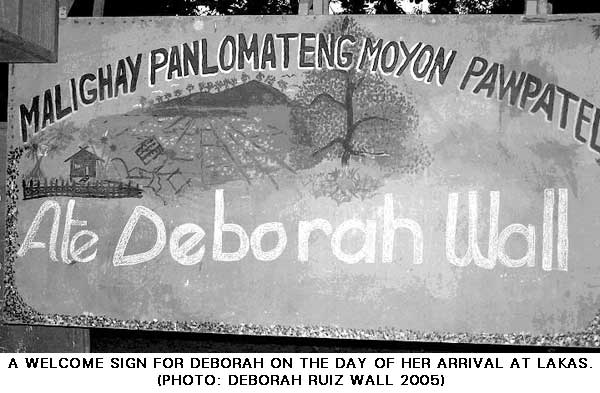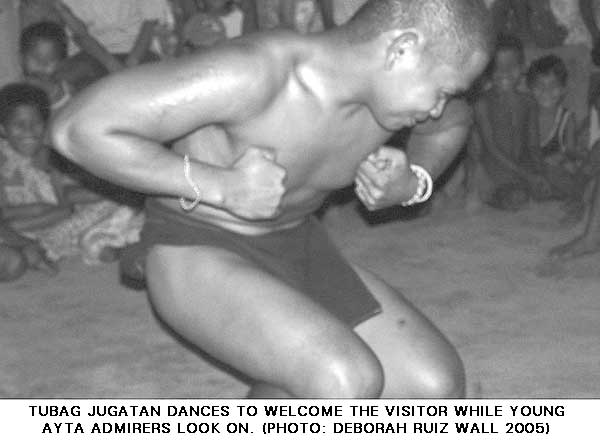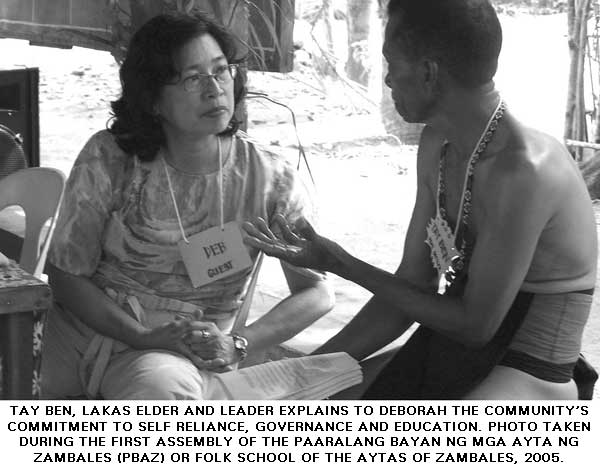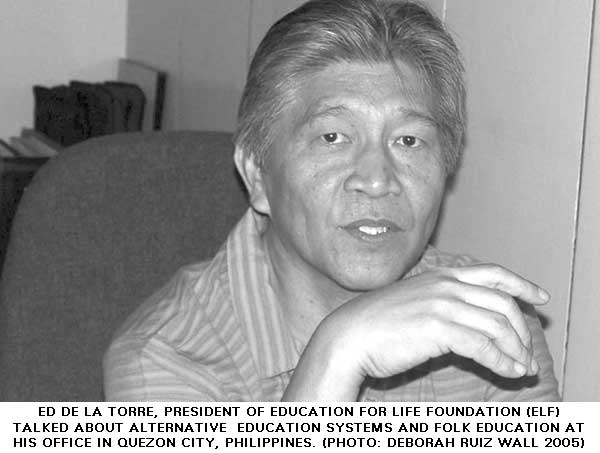KASAMA Vol. 19 No.
3 / July-August-September 2005 / Solidarity Philippines Australia
Network
Education For Life, From Life:
Lessons to be learnt from a strong
indigenous tribe in the Philippines
The Aytas, the first native settlers in
the Philippines were thought to
have arrived some 30,000 to 70,000 years ago. They are from 25
ethnolinguistic groups scattered from Luzon to Mindanao. The over
80,000 Aytas who live in Mount Pinatubo have attracted interest because
of their preserved cultural identity. Sydney resident, DEBORAH RUIZ
WALL who has an interest in indigenous peoples, came to visit the Aytas
recently in Zambales.
 ‘LIFE–LONG
EDUCATION’
‘LIFE–LONG
EDUCATION’ was a catchphrase
that appealed to me when I was doing my training in education at Sydney
Teachers’ College three decades ago. For me, this meant: (1)
one never stops learning, and (2) education that has value is one that
has life–long application.
It wasn’t until April 2005 that I came to witness how this
basic educational philosophy is being used in effect to
re–construct the foundation of a society whose ancestry in
the Philippines goes back some 30,000 to 70,000 years.* This
realization came to me after I visited my indigenous Filipino friends,
the Aytas, in Central Luzon. During my visit, they happened to be
holding the first Assembly of the Paaralang Bayan ng mga Ayta ng
Zambales (PBAZ) or Folk School of the Aytas of Zambales.
‘Self–determination’, another
catchphrase, came to life for me when I saw how the Aytas are applying
their learning to determine their own future in a fast changing global
economy.
I first met Aytas in 1985 as part of an exposure tour with Australian
Teachers Federation members visiting the Philippines hosted by the
Philippine counterpart union, the Alliance of Concerned Teachers. In
1985, the year before President Marcos’ government was
toppled, our group went to Davao, Bataan, Samar, and Botolan. Our
tour’s focus was education but we were also given a broad
sketch of Philippine society and economy.
It was in Botolan, Zambales where I first came across Aytas. Zambales
is a province in Luzon Island north of Manila. We went to a village
called Masikap, and stayed in one of the Aytas’ huts. When we
arrived, one of my companions had a fainting spell. No one knew what to
do because we were far away from ‘civilization’.
The tricycle driver had gone and would not be back till the morning. In
those days, there were no cell/mobile phones for instant communication.
Anyway, one of the Aytas came and since I was the only Pilipino
language speaker, I was asked if the Australians didn’t mind
if they used their local healing method to treat our companion, a
Principal from Adelaide High School. The husband of the woman asked me
if I thought that was all right. I said that it wouldn’t do
any harm. So their healer came with a branch or two, chanted and rubbed
my companion’s knees and legs, and immediately, colour came
back to her face, as though she came back to life. She rose from the
wooden bench where she was lying looking half dead, and was herself
amazed at her instant recovery.
In the Philippines, people either go to a qualified medical
practitioner or to a ‘hilot’ (local healer), or to
both. The following morning in town, my companion asked a practitioner
trained in Western medicine to look at her knees and leg, but he
couldn’t find anything wrong and suggested an x–ray
if she was still concerned. “No, thank you,” she
replied thoughtfully. We noted the link between health and education as
an issue. Apart from this incident, it occurred to us that indigenous
people in Botolan had much to share about their healing techniques and
their local herbal medicine.
Most interesting was the literacy program for Aytas sponsored by a
missionary order. Sister Fe Villanueva gave us a briefing on their
program in Masikap Village which was a mirror image of how mainstream
schools taught literacy. We were tactfully informed by our guide that
another nun up the mountain used a different approach. It was different
because the literacy program was taught not only from the
Aytas’ cultural and linguistic background but also from a
holistic context: which included understanding the
socio–economic environment in which they live.
With lowlanders, the Aytas traded their fruit and vegetable produce
from the mountains. Their lack of literacy and numeracy meant that they
were most often cheated by middlemen and traders. We were exposed to
two different education approaches: one distinctly assimilationist; and
another which contained the seeds of political and economic awareness
and the possibility of self determination. Upon our return to
Australia, participant teachers on the tour gave talks around Sydney,
Brisbane, Melbourne and Adelaide about the result of our exposure.
My re–acquaintance with the Aytas took place in 1999 when
three young Aytas came to Australia on a tour to link up with other
indigenous groups and share their stories. I was living in Redfern,
inner city Sydney at the time doing research about Aboriginal and
non–Aboriginal reconciliation in an urban setting as part of
my Graduate Diploma in Ministry (Theology) with the Sydney College of
Divinity. The three Ayta visitors were: Epang Domulot, Orosco Cabalic
and Tubag Jugatan – ages 15, 17, and 19.
During their visit to Australia, they were accompanied by Sister Carmen
Balazo of the Franciscan Missionaries of Mary (FMM). Sister Carmen,
known as Sister Menggay, provided support to the Aytas’
commitment to self determination and self reliance through introducing
a liberating educational pedagogy. This pedagogy is the Paulo Freire
method of teaching literacy and numeracy with a social context. What
was fascinating about her approach was: she did not proselytize.
Sister Menggay’s religious order was meant to complete its
task with the Aytas in 1992 but Mount Pinatubo erupted in 1991 and the
Aytas had to go down from their mountain home to lowland resettlements.
This was very disruptive because this particular Ayta group, who stuck
together under their banner of ‘LAKAS’ (an acronym
which collectively means ‘strength’), had to deal
with government officials, told where to go and what to do and would
have had to merge with other Ayta groups who did not have the same
holistic orientation in their training.
LAKAS wanted to return to their mountain home after the eruption, but
that was impossible. The place was covered with volcanic ashes (lahar).
Sister Menggay through her initiative was able to secure adequate funds
to purchase a block of land in Bihawo, Botolan to keep the community
together. This did not happen without a struggle, but eventually LAKAS
made it. They began by planting trees around the bare 7.5 hectares of
land and built their huts for the 155 families that live there now.
They also began replanting the mountain, no matter how challenging, on
47.5 hectares of land which LAKAS does not legally own but is under
their stewardship.
Is this a land rights issue? There was no land title system thousands
of years ago. The government recognizes indigenous people’s
‘ancestral domain’ but what this means in terms of
land rights and usage is not entirely clear. A land development plan,
for example, still needs to be drawn up. Recognition is a first step,
and the rest of what this means in practice is a process that needs to
be worked out.

SOME BACKGROUND ABOUT LAKAS
LAKAS stands for Lubos na Alyansa ng mga Katutubong
Ayta ng
Sambales or Negrito Peoples Alliance of Zambales. Formed in 1984 with
45 members from 12 sitios of Barangay Villar and Maguisguis, its main
activities were: literacy classes, cooperative building, and training
on the rights to ancestral domain. It became a Federation in 1985 and
was registered with the Securities and Exchange Commission in 1987.
It has been six years since the Ayta Youth visit to Australia, and now
I was their visitor. The community gave me a welcome under their
wall–less public space. There were speeches and dance
presentations. It was a delight to watch very young Aytas do emceeing
and performing with hardly any inhibition. Such an inspiration, I
thought, for our public speaking classes at TAFE colleges.
At night I was taken to a guest house on the coast in the township of
Botolan belonging to another supporter of the community. The guest
house is a ‘bahay kubo’ – a nipa hut with
bamboo floors, very airy and comfortable as it was situated close to
the sea. The Australian Aboriginal circled–room layout for
gathering is equivalent to the Aytas’ wall–less
open space layout. The basic structure for a gathering is open space
under a roof, and posts planted in the ground or cement to hold the
roof. The place where we had dinner was a long table under a thatched
ceiling directly facing the ocean, so whilst I couldn’t see
the ocean then because it was a moonless night, I could hear the waves
and feel the sea air envelop us as we chatted and ate the fish, rice
and chicken adobo.
The following day was a big day for LAKAS. The first General Assembly
of Indigenous Leader Graduates of Paaralang Bayan ng mga Ayta ng
Zambales (PBAZ/Folk School of the Aytas of Zambales). PBAZ was formed
by the graduates of the Education for Life Foundation (ELF). Some Aytas
have travelled overseas to compare notes with folk school systems in
Denmark, Australia, Canada and the Americas. Some even had the
privilege of meeting Paulo Freire in person in Brazil.
THE FRUITS OF THEIR LABOUR
Some Aytas obtained top school achievements resulting in mainstream
school administrators altering their perception of Aytas. They are
beginning to feel respected and racist thinking and behaviour towards
them are gradually disappearing. They told me that local mainstream
schools are requesting Aytas to teach their folk dances at their
school. Non–Ayta farmers now also request Aytas to give them
training in organic farming and leadership. Respect and recognition of
indigenous skills and knowledge by the wider society help them regain
trust and confidence in their ability to deal with lowlanders on an
equal footing. Their experience shows that a
‘bottom–up’ approach to training can make
an impact.
The morning of the PBAZ Assembly was spent introducing the officers and
the guests (including me), and asking groups to give impromptu
presentations – to sing or dance. The afternoon was serious
business. It was intended to ask the Assembly to make amendments, if
required, and approve their Rules and Policies. Since PBAZ began, 123
Aytas had graduated from a six–week leadership training
course (four are deceased). The course is a prerequisite for membership
of PBAZ. Upon course completion, they can choose to exercise their
newly acquired leadership skills through the seven existing committees:
culture and literacy; health and sports; negotiation and advocacy;
research, documentation and evaluation; education, information and
training; livelihood; finance and membership. Folk education is
community rather than individual oriented. Graduates become aware of
their larger responsibility, and exercise leadership for and with the
community.
I spoke to a few of the guests: the Director for Distance Learning
Program, May Rendon Cinco and the local mayor, Rogelio Yap. I can see
that the aspirations of the Aytas are realized through their own self
determination and negotiation for support with NGOs (non government
organizations) like the Education for Life Foundation and the LGOs
(local government organizations) represented by the Mayor. The Mayor is
able to assist with infrastructure building such as provision of day
care centres, support for out–of–school youth,
irrigation and regeneration with planting 50,000 seedlings. On health
issues he is targeting elimination of tuberculosis and malaria. On
funding, he seeks joint venture projects with agencies such as Asian
Council for People’s Culture (ACPC).
From having hardly any educational opportunities before Sister
Menggay’s Paulo Freire literacy program, LAKAS today prides
itself with four university graduates, ten continuing university
students, and many high school and primary school children all
studying. The focus is not on money but on community building. People
who finish their degrees have to serve for two years within the
community, and when they start to work outside the community they are
expected to contribute a proportion of their income to LAKAS. If anyone
marries outside the community, they can only continue to live in the
community if their spouse believes in its ethos and is prepared to
abide by community precepts. Such measures are intended to ensure that
the strength of the community is not undermined.

COMMUNITY GOVERNANCE
Community Governance is what fascinates and impresses me with LAKAS.
Everyone from the age of reason is taught to make decisions
collectively and to practise leadership and negotiation skills. LAKAS
is very particular about moulding minds right from infancy and being
community– minded. There are categories of belonging within
the community: the very young (e.g. under six years), primary school
age, secondary school age, LAKAS youth, men, women, and the aged.
Decisions reached are consolidated at the community level.
Back in Manila, I met Edicio de la Torre who used to be a Society of
Divine Word (SVD) priest and whose work on liberation theology I read
when I was doing my sociology thesis about church–state
relations. He is no longer a priest and is currently the President of
the Education for Life Foundation (ELF). ELF initially provided LAKAS
the 6–week leadership training course. LAKAS responded to the
challenge of conducting its own training based on a
train–the–trainer system.
Under President Marcos’ dictatorship, Ed was put in gaol for
nine years. Many human rights activists suffered the same fate. These
long years in gaol gave Ed the opportunity to think things through.
Upon his release from prison in 1986, he thought that while the people
had overthrown the dictatorship, much more needed to be done. Popular
democracy had to be rebuilt from the ground up. There would need to be
a new generation of leaders aware of their rights and ready to defend
them. They would need negotiation skills to talk to those holding
positions of power and influence. To flesh out his vision, he helped
establish the Institute for Popular Democracy (IPD). IPD wanted to
develop a comprehensive leadership formation program, which would not
only change poor people’s quality of life but include
everything that underpins sustainable and equitable development.
Ed discovered during a Popular Education Consultation in 1986 that many
people shared his vision. As a result of two conferences, a network
called Popular Education for People’s Empowerment (PEPE) was
formed. In 1987, Ed attended a conference at Hillerod Hojskole, a
school in Denmark, and found himself ‘staring at his
dream’: the folkehojskole (or folk school). He found that the
idea of a folk school was not new — the Danish in the 1830s
had a visionary, Nikolaj Frederik Severin Grundtvig.
Grundtvig’s country in 1783 was in a time of change.
Political reforms were taking place. Their national identity was
eroding, their monarchy was weakening, their self confidence was being
undermined by the loss of territory to Germany. Some of the people were
becoming extremely rich, but the majority were poor. The boy, Grundtvig
was searching for his own identity. Fortunately he was filled with folk
tales and songs of his Nordic tradition by his mother and another
elderly woman. He knew who he was, what his roots were, and where he
belonged. He dreamt then of helping his people remember their roots
through establishing an education for the poor majority, the almue
(root word: almuegjort or ‘made to be ignorant’).
During Grundtvig’s time, the almue were mostly farmers who
were excluded from any political decision–making. The folk
school he envisioned would be about life and teach purposeful living.
Through storytelling, poetry and song, students would learn about their
identity and cultural heritage. They would interact with each other as
co–learners. It would be an education for the whole of life.
It took 15 years for this vision to materialize. In 1844, The Rodding
Hojskole was founded by Christian Flor, a professor of the Danish
language at Cologne University. Other folk schools were founded later
in different parts of the country, and now, over 100 folk schools exist
in Denmark; 128 in Sweden; 93 in Finland and a few others in Iceland
and Faroe Islands.
And so it was in 1987 that Ed de la Torre sent word to IPD about the
folkehojskole and how such a school could be established in the
Philippines. In 1991, Ed was in the Netherlands. He and his partner,
Girlie Villariba wondered whether, with the help of the Danish, it was
possible to build a folkehojskole in the Philippines. At this time IPD
was experimenting with different leadership formation
programs. Ed and Girlie approached a funding agency, and the result was
positive. A proposal was put together within a few days which included
the result of village consultations with grassroots leaders as well as
with NGOs experienced in popular education. An alternative education
system was conceived with the twin aims of empowerment and sustainable
development rooted in the community. To encourage the folk school
project, the Education for Life Foundation was established.

Girlie Villariba and Marichu C. Antonio were ELF’s first
staff. With partnerships as their tools and ideas as their materials,
the school was built between 1991 and 1992. ELF’s NGO
partners were: the Institute for Popular Democracy which developed
the comprehensive leadership training program; the Philippine Rural
Reconstruction Movement’s program for sustainable development
and democratization in rural districts; the Cooperatives Foundation of
the Philippines, Inc which organizes cooperatives for the poor; the
Center for Urban Community Development which applies these concepts for
the urban poor; and Popular Education for People Empowerment, a network
of popular educators. With these partners, ELF was able to put up a
proposal to Danchurchaid. The proposal was approved, and the funding
was to come from the Danish International Development Agency (DANIDA).
The next challenge was the process: how to implement this vision in the
Philippine context. It was decided to strengthen the local
organizations of the poor sections of rural and urban communities by
training their leaders. Before the six–week residential
formation course was conducted, there had to be a curriculum. Concepts
and themes were drawn up through informal discussions and formal
workshops with popular educators, development workers and activists
including specialists and resource persons. This phase of the program
was called pagbibinhi, or selecting seeds and growing seedlings. The
water to nourish the seedlings would be the philosophy of
‘education from life and for life’. The seeds were:
people’s empowerment, grassroots leadership, Filipino
psychology and culture, ethnicity, nationalism, popular economics,
tradition and rituals, gender sensitivity, pluralism, coalition,
learning to learn, learning to lead, learning from life and for life,
and negotiations.
ELF thought that a story–telling workshop where participants
share highlights of their lives and stories of their communities, their
values, tradition, the problems they face, and their leadership
experiences would be a useful preliminary workshop before participants
begin the course. This sharing would be documented and would become
part of their training material. This is truly ‘education
from life’.
And now ELF’s and LAKAS’ effort has borne fruit.
Graduates of the ELF six–week training course have now reaped
a new harvest and sown yet another seed: the formation of PBAZ
— a folk school for Aytas in Zambales in partnership with
LAKAS and ELF. Their goal in having their own school is to be able to
lift their quality of life and have a peaceful and progressive
community.
In formal schools, young indigenous people often face discrimination
and are discouraged from attending classes. In 2003, PBAZ conducted a
General Leadership and Alternative Learning System course. Topics
covered in the leadership training course included: philosophy and
process of learning, presentation of self and ideas, communication to
small groups, ecosystem, conflict management, leadership and
organization, leadership and empowerment, sports, Ayta culture, and the
Indigenous People’s Rights Act.
FOLK SCHOOL FOR AYTAS
More seeds can be sown from my meeting with Ed de la Torre. Already we
can see a sharing of experiences between indigenous peoples in
Australia and in the Philippines on life–long education and
alternative learning systems. Ed told me about ‘Biyaheng
Ayta’ (Aytas’ journey), a theatre group that
travels to various Ayta communities covering themes such as history
(elders) and youth (land and dance). Ed is interested to learn about
the process involved in certifying indigenous skills such as bolo
making or basket–weaving and other indigenous arts and
craftwork to give recognition to these practical skills and to ensure
that they are not lost.
In Australia, we have had some years of experience now in the
application of ‘Recognition for Prior learning’. We
also have an indigenous education system: Tranby Aboriginal Cooperative
College in Sydney and Nungalinya College, an ecumenical theology
college in Darwin. EORA Centre, an Aboriginal College, also exists
within the Technical and Further Education Commission in Sydney.
I see that indigenous people from Australia can benefit from seeing how
the whole–of–life education process and alternative
education system are applied by ELF and PBAZ in a rural setting. I see
that indigenous people from the Philippines can learn from the
challenges experienced in Australia in setting up an independent
indigenous–run educational establishment and how skills from
prior learning are recognized and certified.
Before becoming President of ELF, Ed held the position of Director of
Technical Education and Schools Development Authority (TESDA). TESDA in
the Philippines is similar to TAFE in Australia — a
government agency providing technical education and skills development
programs. It endeavours to work in partnership with local industry and
with people who need particular skills to gain entry into the job
market. Perhaps another joint venture is in the offing beginning with
sharing of experiences that would benefit both communities across the
seas.
It all starts from a vision, imagination, a dream. Seeds to be sown
from life, for life.
ABOUT THE AUTHOR:
DEBORAH WALL was born
in the Philippines. She is
currently a member of the Executive Board of the NSW Reconciliation
Council whose aim is to propagate reconciliation between Aboriginal and
non–Aboriginal Australians
REFERENCES:
Padma Perez (1999) ELF Story Book: Paaralang Bayan, Paaralang Buhay,
Education for Life Foundation: Quezon City, Philippines.
Salinbuhay, from life, for life, August 2003 No 16.
*NOTE: The exact time of the first appearance of Negritos in the
islands is a contentious issue, but it is largely accepted that they
represent the most ancient prehistoric peopling of Asia going back as
much as 70,000 years. (see
http://en.wikipedia.org/wiki/Negritos).
 Home | Aims and Objectives of Solidarity Philippines Australia Network | About Kasama
Home | Aims and Objectives of Solidarity Philippines Australia Network | About Kasama 